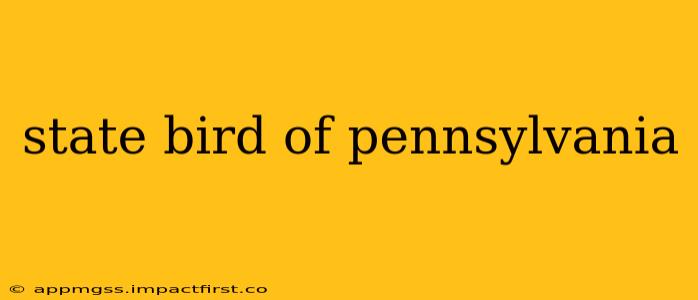Pennsylvania's state bird, the Ruffed Grouse ( Bonasa umbellus), is a captivating avian resident, embodying the state's rich natural heritage. This article delves into the fascinating aspects of this bird, exploring its characteristics, habitat, and significance as Pennsylvania's official symbol.
What Makes the Ruffed Grouse Unique?
The Ruffed Grouse is a medium-sized bird, easily identifiable by its distinctive ruff of feathers around its neck—a feature particularly prominent in males during courtship displays. These ruffs, along with their mottled brown, gray, and black plumage, provide exceptional camouflage within their woodland habitats. Their size varies slightly depending on sex and geographic location, but generally, they range from 16 to 19 inches in length. Both males and females exhibit similar coloration, though males tend to be slightly larger.
Where Does the Ruffed Grouse Live?
The Ruffed Grouse thrives in forested areas, particularly those with a mix of mature and young trees offering diverse foraging and nesting opportunities. They prefer areas with dense undergrowth, providing cover from predators and shelter from harsh weather. You'll find them in a variety of forest types, from hardwood forests to mixed conifer-hardwood stands, across Pennsylvania. Their ability to adapt to varying habitats contributes to their widespread presence throughout the state.
What Does the Ruffed Grouse Eat?
The Ruffed Grouse's diet is largely dependent on the season. In the spring and summer, they primarily consume insects, buds, and leaves. As autumn approaches, their diet shifts towards berries, seeds, and nuts, helping them build up fat reserves for the winter months. During winter, they rely heavily on buds, twigs, and fallen seeds, often foraging on the ground amongst the snow cover. Their adaptable diet is crucial to their survival in Pennsylvania's diverse ecosystems.
What is the significance of the Ruffed Grouse as Pennsylvania's state bird?
The Ruffed Grouse was officially designated as Pennsylvania's state bird in 1931. Its selection reflects the state's appreciation for its native wildlife and the importance of preserving its natural resources. The bird's prevalence across the state further solidified its symbolic representation. It represents the abundant wildlife and the state's commitment to conservation efforts.
How many Ruffed Grouse are there in Pennsylvania?
The exact population of Ruffed Grouse in Pennsylvania fluctuates yearly depending on several factors including habitat availability, weather patterns, and predation. While precise numbers are challenging to obtain, regular surveys and population monitoring are conducted by wildlife agencies to track their populations and inform conservation strategies.
What are the threats to the Ruffed Grouse population?
Like many wildlife species, Ruffed Grouse face several challenges. Habitat loss due to deforestation and urbanization is a significant threat, limiting their nesting and foraging grounds. Predation from hawks, owls, foxes, and other animals also plays a role in population dynamics. Disease and harsh weather conditions can further impact their survival rates. Conservation efforts focus on habitat protection and management to mitigate these threats.
Is the Ruffed Grouse endangered in Pennsylvania?
The Ruffed Grouse is not currently classified as endangered in Pennsylvania. However, maintaining healthy populations requires ongoing conservation efforts, including habitat management, responsible hunting practices, and public awareness campaigns to protect these birds and their environment. The continued monitoring of their numbers is essential for effective conservation strategies.
In conclusion, the Ruffed Grouse serves as more than just Pennsylvania's state bird; it symbolizes the state's commitment to wildlife conservation and the beauty of its natural landscapes. Its story reminds us of the importance of preserving habitats and protecting the diverse wildlife that calls Pennsylvania home.
